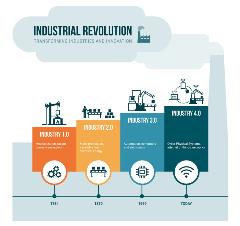Earlier this year, Dr. Vivian Balakrishnan, Minister-in-charge of Singapore's Smart Nation initiative, jokingly challenged A-levels students to write an artificial intelligence (AI) programme that could take the exams for them.
The way exams are conducted today is "archaic and belongs to the previous industrial revolution," said Dr. Balakrishnan. As the fourth industrial revolution dawn upon us globally, bringing enormous disruptions, there is a need to prepare ourselves for the dynamic workplace for the future.
To do so, we have to move beyond the traditional skillsets. But how do we prepare ourselves for jobs that don’t yet exist?
 While you can never be 100 percent sure of what is to come, there are some skills that are crucial to the Industry 4.0 workforce, said Khoong Chan Meng, Director and Chief Executive Officer, NUS ISS.
While you can never be 100 percent sure of what is to come, there are some skills that are crucial to the Industry 4.0 workforce, said Khoong Chan Meng, Director and Chief Executive Officer, NUS ISS.
For instance, cyber-physical systems are a huge part of the fourth industrial revolution. The critical infrastructure, which includes the electrical power and water supply, is now tightly integrated with digital networks and systems. This means that it is now easier and safer for cyber criminals to carry out sabotage on the physical infrastructure.
Hence, future-ready skillsets need to be more integrative across disciplines – companies as well as educational institutes need to adopt a more holistic look at the training and development of the workforce.
Human and machine coexistence in the future workplace
 Another key aspect of the fourth industrial revolution is the development of smarter systems that have moved beyond just computers and automation.
Another key aspect of the fourth industrial revolution is the development of smarter systems that have moved beyond just computers and automation.
Machines are now able to do many things that in the past only humans can do. These things include problem solving, predictions, medical diagnosis, and even financial advisories. They have since taken over jobs that human workers used to do, and this affects not just the people already displaced, but also those who are not yet displaced.
These technologies are here to stay. Thus, as we leverage the smartness of the machines, we need to constantly think ahead about how to value-add as a human producer of work – and this value can be found in business application of technology.
For instance, when we deploy robots in a hotel setting, the existing work processes of the organisation – such as the way the rest of the human workers operate, and how the service is being rendered to the customers – might have to be streamlined in different ways. This work re-design, also sometimes known as service design, ensures that innovations can be effectively deployed in a real-world setting. The knowledge of how this can be done goes beyond the technical knowledge of a professional. It is a complex area, and the depth of the skills required can be quite extensive.
The importance of mastering critical competencies
Companies therefore need employees with deep mastery of critical competencies, which are “critical from a standpoint of helping a company to transform – they are areas where a lot of depth needs to be built in,” explained Chan Meng.
For instance, in the case of analytics, how does a company manage and understand the data collected, and then tell a story about these data? From there, how can the organisation then arrive at a business vision or insight about the market situation, to come up with strategies to address the issues faced?
As an employee in the company, one needs to strive to achieve mastery of the critical skills, to be able to apply domain and technical knowledge to business settings. There are two aspects to skills mastery – technicalities and business acumen.
While technicalities – in terms of techniques and methods – are important, digital transformation calls for the capability of a professional to be able to relate the digital skills to the business and real-world scenarios. “There is a need for each member of the business organisation to understand how to apply methods to a business context which may be chaotic and unstructured. One has to be able to make sense of such market situations, and this requires depth in terms of understanding business practices, and how business processes work,” said Chan Meng.
These horizontal skills call for a fundamental need for people to be better at solving problems and designing solutions, he added.
Digital transformation at the level of the individual
From a historical perspective, there is also a drastic shift in the kind of skills that companies are looking for.
“In the past, companies usually seek skills that are very job- and task-specific, and in very traditional areas,” said Chan Meng. “But increasingly, there is a shift towards wanting employees to acquire a digital mindset.”
Organisations are now trying to get their employees to think about how they can transform themselves and value-add. This would require individuals to pick up new skills which may seem unrelated to the traditional job function, but are tools that will complement their functional skillsets to transform them into a digital professional.
“This wave of digital transformation has now reached the level of the individual,” Chan Meng explained. “Over the past few years, companies have been nudged or encouraged to undertake digital transformation. Currently, it has shifted to a more active process in which the companies are bringing digital transformation down to the micro level, to transform the individual worker to in turn, effect a business transformation.”
Moving beyond the excitement of digital transformation
All in all, the crux of the concern is whether employees would be able to apply their new skills to achieve business outcomes. “People have to go well beyond just being excited about emerging skills and trends,” Chan Meng stressed.
Therefore, a key national initiative that NUS-ISS is currently supporting, is to get people aware of the critical skills areas. The programmes offered are packaged in such a way that these critical competencies are accessible and clear to the industry. “It is important to map out a learning journey from the foundation to the intermediate and advanced programmes. We want to provide a roadmap for the professionals to pursue as they leverage these new skills,” Chan Meng said.
In addition to enhancing, upgrading and learning adjacent skillsets, employees also need to be able to align their up-skilling roadmap with their company’s business transformation objectives as well.
This is so that at the end of the day, their learning, instead of just being a casual process, will carry a wider purpose within the context of the entire digital business.